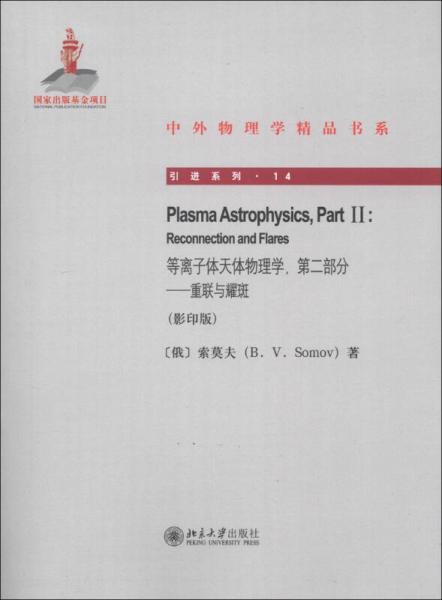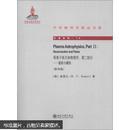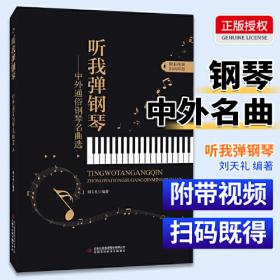中外物理学精品书系·引进系列(14)·等离子体天体物理学(第2部分):重联与耀斑(影印版)
作者:
[俄] 索莫夫
(B.V.Somov) 著
出版时间:
2012-12
版次:
1
ISBN:
9787301215579
定价:
72.00
装帧:
平装
开本:
16开
纸张:
胶版纸
页数:
413页
字数:
479千字
正文语种:
英语
-
为有力推动我国物理学研究、加快相关学科的建设与发展,特别是展现近年来中国物理学者的研究水平和成果,北京大学出版社在国家出版基金的支持下推出了《中外物理学精品书系》,试图对以上难题进行大胆的尝试和探索。《中外物理学精品书系·引进系列(14)·等离子体天体物理学(第2部分):重联与耀斑(影印版)》编委会集结了数十位来自内地和香港顶尖高校及科研院所的知名专家学者。他们都是目前该领域十分活跃的专家,确保了整套丛书的权威性和前瞻性。
《中外物理学精品书系·引进系列(14)·等离子体天体物理学(第2部分):重联与耀斑(影印版)》内容丰富,涵盖面广,可读性强,其中既有对我国传统物理学发展的梳理和总结,也有对正在蓬勃发展的物理学前沿的全面展示;既引进和介绍了世界物理学研究的发展动态,也面向国际主流领域传播中国物理的优秀专著。可以说,《中外物理学精品书系》力图完整呈现近现代世界和中国物理科学发展的全貌,是一部目前国内为数不多的兼具学术价值和阅读乐趣的经典物理丛书。
《中外物理学精品书系》另一个突出特点是,在把西方物理的精华要义“请进来”的同时,也将我国近现代物理的优秀成果“送出去”。物理学科在世界范围内的重要性不言而喻,引进和翻译世界物理的经典著作和前沿动态,可以满足当前国内物理教学和科研工作的迫切需求。另一方面,改革开放几十年来,我国的物理学研究取得了长足发展,一大批具有较高学术价值的著作相继问世。这套丛书首次将一些中国物理学者的优秀论著以英文版的形式直接推向国际相关研究的主流领域,使世界对中国物理学的过去和现状有更多的深人了解,不仅充分展示出中国物理学研究和积累的“硬实力”,也向世界主动传播我国科技文化领域不断创新的“软实力”,对全面提升中国科学、教育和文化领域的国际形象起到重要的促进作用。 1MagneticReconnection
1.1Whatismagneticreconnection?
1.1.1Neutralpointsofamagneticfield
1.1.2Reconnectioninvacuum
1.1.3Reconnectioninplasma
1.1.4Threestagesinthereconnectionprocess
1.2Accelerationincurrentlayerswhyandhow?
1.2.1Theoriginofparticleacceleration
1.2.2Accelerationinaneutralcurrentlayer
1.3Practice:ExercisesandAnswers
2ReconnectioninaStrongMagneticField
2.1Smallperturbationsnearaneutralline
2.1.1Historicalcomments
2.1.2Reconnectioninastrongmagneticfield
2.1.3AlinearizedprobleminidealMHD
2.1.4Convergingwavesandthecumulativeeffect
2.2Largeperturbationsneartheneutralline
2.2.1Magneticfieldlinedeformations
2.2.2Plasmadensityvariations
2.3Dynamicdissipationofmagneticfield
2.3.1Conditionsofappearance
2.3.2Thephysicalmeaningofdynamicdissipation
2.4NonstationaryanalyticalmodelsofRCL
2.4.1Self-similar2DMHDsolutions
2.4.2Magneticcollapseatthezerothpoint
2.4.3Fromcollisionaltocollisionlessreconnection
3EvidenceofReconnectioninSolarFlares
3.1Theroleofmagneticfields
3.1.1Basicquestions
3.1.2Conceptofmagneticreconnection
3.1.3Someresultsofobservations
3.2Three-dimensionalreconnectioninfiares
3.2.1Topologicalmodelofanactiveregion
3.2.2Topologicalportraitofanactiveregion
3.2.3Featuresofthefiaretopologicalmodel
3.2.4TheS-likemorphologyanderuptiveactivity
3.3Acurrentlayerasthesourceofenergy
3.3.1Pre-flareaccumulationofenergy
3.3.2Flareenergyrelease
3.3.3TheRCLasapartofanelectriccircuit
3.4Reconnectioninaction
3.4.1SolarflaresoftheSyrovatskytype
3.4.2Sakao-typeflares
3.4.3Newtopologicalmodels
3.4.4Reconnectionbetweenactiveregions
4TheBastilleDay2000Flare
4.1Mainobservationalproperties
4.1.1Generalcharacteristicsoftheflare
4.1.2OverlayHXRimagesonmagnetograms
4.1.3Questionsofinterpretaion
4.1.4MotionoftheHXRkernels
4.1.5Magneticfieldevolution
4.1.6TheHXRkernelsandfieldevolution
4.2Simplifiedtopologicalmodel
4.2.1Photosphericfieldmodel.Topologicalportrait
4.2.2Coronalfieldmodel.Separators
4.2.3Chromosphericribbonsandkernels
4.2.4Reconnectedmagneticflux.Electricfield
4.2.5Discussionoftopologicalmodel
5ElectricCurrentsRelatedtoReconnection
5.1Magneticreconnectioninthecorona
5.1.1Planereconnectionmodelasastartingpoint
5.1.2Three-componentreconnection
5.2Photosphericshearandcoronalreconnection
5.2.1Accumulationofmagneticenergy
5.2.2FlareenergyreleaseandCMEs
……
6ModelsofReconnectingCurrentLayers
7ReconnectionandCollapsingTrapsinSolarFlares
8Solar-typeFlaresinLaboratoryandSpace
9ParticleAccelerationinCurrentLayers
10StructuralInstabilityofReconnectingCurrentLayers
11TearingInstabilityofReconnectingCurrentLayers
12MagneticReconnectionandTurbulence
13ReconnectioninWeakly-IonizedPlasma
14MagneticReconnectionofElectricCurrents
Epilogue
Appendix1.Acronyms
Appendix2.Notation
Appendix3.UsefulFormulae
Appendix4.Constants
Bibliography
Index
-
内容简介:
为有力推动我国物理学研究、加快相关学科的建设与发展,特别是展现近年来中国物理学者的研究水平和成果,北京大学出版社在国家出版基金的支持下推出了《中外物理学精品书系》,试图对以上难题进行大胆的尝试和探索。《中外物理学精品书系·引进系列(14)·等离子体天体物理学(第2部分):重联与耀斑(影印版)》编委会集结了数十位来自内地和香港顶尖高校及科研院所的知名专家学者。他们都是目前该领域十分活跃的专家,确保了整套丛书的权威性和前瞻性。
《中外物理学精品书系·引进系列(14)·等离子体天体物理学(第2部分):重联与耀斑(影印版)》内容丰富,涵盖面广,可读性强,其中既有对我国传统物理学发展的梳理和总结,也有对正在蓬勃发展的物理学前沿的全面展示;既引进和介绍了世界物理学研究的发展动态,也面向国际主流领域传播中国物理的优秀专著。可以说,《中外物理学精品书系》力图完整呈现近现代世界和中国物理科学发展的全貌,是一部目前国内为数不多的兼具学术价值和阅读乐趣的经典物理丛书。
《中外物理学精品书系》另一个突出特点是,在把西方物理的精华要义“请进来”的同时,也将我国近现代物理的优秀成果“送出去”。物理学科在世界范围内的重要性不言而喻,引进和翻译世界物理的经典著作和前沿动态,可以满足当前国内物理教学和科研工作的迫切需求。另一方面,改革开放几十年来,我国的物理学研究取得了长足发展,一大批具有较高学术价值的著作相继问世。这套丛书首次将一些中国物理学者的优秀论著以英文版的形式直接推向国际相关研究的主流领域,使世界对中国物理学的过去和现状有更多的深人了解,不仅充分展示出中国物理学研究和积累的“硬实力”,也向世界主动传播我国科技文化领域不断创新的“软实力”,对全面提升中国科学、教育和文化领域的国际形象起到重要的促进作用。
-
目录:
1MagneticReconnection
1.1Whatismagneticreconnection?
1.1.1Neutralpointsofamagneticfield
1.1.2Reconnectioninvacuum
1.1.3Reconnectioninplasma
1.1.4Threestagesinthereconnectionprocess
1.2Accelerationincurrentlayerswhyandhow?
1.2.1Theoriginofparticleacceleration
1.2.2Accelerationinaneutralcurrentlayer
1.3Practice:ExercisesandAnswers
2ReconnectioninaStrongMagneticField
2.1Smallperturbationsnearaneutralline
2.1.1Historicalcomments
2.1.2Reconnectioninastrongmagneticfield
2.1.3AlinearizedprobleminidealMHD
2.1.4Convergingwavesandthecumulativeeffect
2.2Largeperturbationsneartheneutralline
2.2.1Magneticfieldlinedeformations
2.2.2Plasmadensityvariations
2.3Dynamicdissipationofmagneticfield
2.3.1Conditionsofappearance
2.3.2Thephysicalmeaningofdynamicdissipation
2.4NonstationaryanalyticalmodelsofRCL
2.4.1Self-similar2DMHDsolutions
2.4.2Magneticcollapseatthezerothpoint
2.4.3Fromcollisionaltocollisionlessreconnection
3EvidenceofReconnectioninSolarFlares
3.1Theroleofmagneticfields
3.1.1Basicquestions
3.1.2Conceptofmagneticreconnection
3.1.3Someresultsofobservations
3.2Three-dimensionalreconnectioninfiares
3.2.1Topologicalmodelofanactiveregion
3.2.2Topologicalportraitofanactiveregion
3.2.3Featuresofthefiaretopologicalmodel
3.2.4TheS-likemorphologyanderuptiveactivity
3.3Acurrentlayerasthesourceofenergy
3.3.1Pre-flareaccumulationofenergy
3.3.2Flareenergyrelease
3.3.3TheRCLasapartofanelectriccircuit
3.4Reconnectioninaction
3.4.1SolarflaresoftheSyrovatskytype
3.4.2Sakao-typeflares
3.4.3Newtopologicalmodels
3.4.4Reconnectionbetweenactiveregions
4TheBastilleDay2000Flare
4.1Mainobservationalproperties
4.1.1Generalcharacteristicsoftheflare
4.1.2OverlayHXRimagesonmagnetograms
4.1.3Questionsofinterpretaion
4.1.4MotionoftheHXRkernels
4.1.5Magneticfieldevolution
4.1.6TheHXRkernelsandfieldevolution
4.2Simplifiedtopologicalmodel
4.2.1Photosphericfieldmodel.Topologicalportrait
4.2.2Coronalfieldmodel.Separators
4.2.3Chromosphericribbonsandkernels
4.2.4Reconnectedmagneticflux.Electricfield
4.2.5Discussionoftopologicalmodel
5ElectricCurrentsRelatedtoReconnection
5.1Magneticreconnectioninthecorona
5.1.1Planereconnectionmodelasastartingpoint
5.1.2Three-componentreconnection
5.2Photosphericshearandcoronalreconnection
5.2.1Accumulationofmagneticenergy
5.2.2FlareenergyreleaseandCMEs
……
6ModelsofReconnectingCurrentLayers
7ReconnectionandCollapsingTrapsinSolarFlares
8Solar-typeFlaresinLaboratoryandSpace
9ParticleAccelerationinCurrentLayers
10StructuralInstabilityofReconnectingCurrentLayers
11TearingInstabilityofReconnectingCurrentLayers
12MagneticReconnectionandTurbulence
13ReconnectioninWeakly-IonizedPlasma
14MagneticReconnectionofElectricCurrents
Epilogue
Appendix1.Acronyms
Appendix2.Notation
Appendix3.UsefulFormulae
Appendix4.Constants
Bibliography
Index
查看详情
-
八五品
广西南宁市
平均发货5小时
成功完成率97.05%
-
九品
河南省平顶山市
平均发货23小时
成功完成率73.36%
-
2012-12 印刷
九品
北京市海淀区
平均发货18小时
成功完成率87.35%
-
九品
河南省平顶山市
平均发货23小时
成功完成率73.36%
-
九五品
河北省廊坊市
平均发货1小时
成功完成率98.65%
-
九五品
湖北省武汉市
平均发货25小时
成功完成率79.18%
-
九五品
北京市通州区
平均发货29小时
成功完成率82.52%
-
九品
河南省平顶山市
平均发货23小时
成功完成率73.36%
-
九品
北京市东城区
平均发货25小时
成功完成率89.43%
-
九品
北京市海淀区
平均发货23小时
成功完成率89.81%

 占位居中
占位居中



























